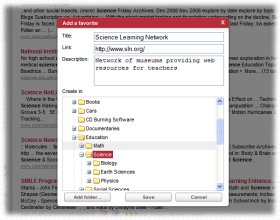|
Education
Web
Viewing 1-3 of 3 total results
Scholastic: Tall as a Mountain, Flat as a Plain
have dried, use glue to affix them to the base. DAY 3 After landforms have dried… Step 1: Set out newspapers on desks and paint cups for each pair of students. Distribute topographic models to the students. Step 2: Show students the topographic globe again. Indicate th...
evidence is required to evaluate hypotheses and explanations; c) comparing different scientific explanations for a set of observations about the Earth; d) explaining that observation and logic are essential for reaching a conclusion; and e) evaluating evidence for scientific the...
1
0
evidence is required to evaluate hypotheses and explanations; c) comparing different scientific explanations for a set of observations about the Earth; d) explaining that observation and logic are essential for reaching a conclusion; and e) evaluating evidence for scientific theories. ES.3 The student will investigate and understand how to read and interpret maps, globes, models, charts, and imagery. Key concepts include a) maps (bathymetric, geologic, topographic, and weather) and star charts; b) imagery
31
0
http://www.doe.virginia.gov/VDOE/Superintendent/Sols/sciencesol.pdf#page=31
www.doe.virginia.gov/VDOE/Superintendent/Sols/sciencesol.pdf#page=31
evidence is required to evaluate hypotheses and explanations; c) comparing different scientific explanations <span class="highlight">for</span> a set of observations about the Earth; d) explaining that observation and logic are essential <span class="highlight">for</span> reaching a conclusion; and e) evaluating evidence <span class="highlight">for</span> scientific theories. ES.3 The student will investigate and understand how to read and interpret <span class="highlight">maps</span>, globes, models, charts, and imagery. Key concepts include a) <span class="highlight">maps</span> (bathymetric, geologic, <span class="highlight">topographic</span>, and weather) and star charts; b) imagery
terms. g. Recognize the usefulness and limitations of models and theories as scientific representations of reality. h. Read and interpret topographic and geologic maps. i. Analyze the locations, sequences, or time intervals that are characteristic of natural phenomena...
1
0
terms. g. Recognize the usefulness and limitations of models and theories as scientific representations of reality. h. Read and interpret topographic and geologic maps. i. Analyze the locations, sequences, or time intervals that are characteristic of natural phenomena (e.g., relative ages of rocks, locations of planets over time, and succession of species in an ecosystem). j. Recognize the issues of statistical variability and the need for controlled tests. k. Recognize the cumulative nature of
61
0
http://www.cde.ca.gov/be/st/ss/documents/sciencestnd.pdf#page=61
www.cde.ca.gov/be/st/ss/documents/sciencestnd.pdf#page=61
terms. g. Recognize the usefulness and limitations of models and theories as scientific representations of reality. h. Read and interpret <span class="highlight">topographic</span> and geologic <span class="highlight">maps</span>. i. Analyze the locations, sequences, or time intervals that are characteristic of natural phenomena (e.g., relative ages of rocks, locations of planets over time, and succession of species in an ecosystem). j. Recognize the issues of statistical variability and the need <span class="highlight">for</span> controlled tests. k. Recognize the cumulative nature of
|
